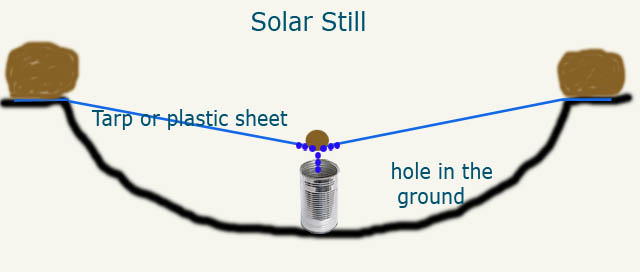How To Make a Solar Still
A solar still will provide you with 100% pure water, and will not require purification or boiling prior to drinking.
The solar still technique will work just about anywhere, provided that there is enough sunlight to assist the process. Here are simple instructions how to build a solar still to extract pure drinking water from the earth.
Find, or dig a hole in the ground, the size depending on how quickly you wish to extract water and also depending on the available size of your tarp or plastic to cover it.
Lay a tarp or plastic across the diameter of the hole and procure enough rocks, logs, or other improvisations to use for sealing the perimeter of the tarp.
While in the process of sealing the perimeter of the tarp, set a container in the center of the dug-out-hole, which will coincide with the position of a medium weight stone placed on top of the tarp – providing a drip point into the container underneath (see solar-still illustration above).
Note: You’re not punching a hole in the tarp, you’re just placing a stone on top so that the water which condensates underneath the tarp, will drip into the container.
The heat of the sun beating down on the tarp (which is now sealed over the hole in the ground,) will heat up the air which is trapped underneath and will evaporate some of the moisture that is in the ground. The moisture will condense on the inside of the plastic or tarp, and then drip down towards the center and into the container.
Since the water is created from the condensation process, it is therefore 100% pure and ready to drink (provided that your tarp or plastic is clean).
Tip: It is important to seal the perimeter as best as possible to prevent heated air from escaping. You can add other things in the hole itself, to provide even more evaporated water… things like vegetation or other items that may be damp. Since the process is condensation, it won’t matter where the water came from with regards to purity.
Where there is a larger difference of daytime and nighttime temperatures, the more likely the effect, especially with moist soil/substance to work with.

